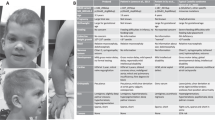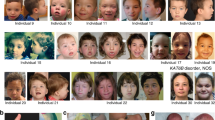Abstract
Noonan syndrome (NS) and cardio-facio-cutaneous (CFC) syndrome are the most common subtypes of RASopathy. As an effector of Ras, BRAF is one of the molecules responsible for RASopathy. We investigated the phenotypic and genotypic features of 26 patients with BRAF-associated RASopathy. The clinical diagnoses were CFC (n = 21, 80.8%), NS (n = 3, 11.5%), NS/CFC (n = 1, 3.8%), and undefined syndromic intellectual disability (ID) (n = 1, 3.8%). The mostly shared phenotypes were ID (90.5%), cutaneous manifestations (84.6%), congenital heart defects (76.9%), short stature (76.9%), and dysmorphic features such as short neck (65.4%) and low-set ears (65.4%). Importantly, moderate to severe ID (57.1%) and epilepsy (26.9%) were noted. Eighteen different missense mutations were found, including a novel mutation, p.Phe498Tyr. p.Gln257Arg (n = 9, 34.6%) was the most common mutation, and the mutations were clustered in the cysteine-rich domain or protein kinase domain. A review of previously reported cases along with our findings revealed the existence of multiple sub-phenotypes of RASopathy within a single genotype, indicating that BRAF-associated RASopathy is not variant-specific. Our study further delineated the diverse and expanded clinical phenotypes of BRAF-associated RASopathy with their molecular genetic characteristics.
This is a preview of subscription content, access via your institution
Access options
Subscribe to this journal
Receive 12 print issues and online access
$259.00 per year
only $21.58 per issue
Buy this article
- Purchase on Springer Link
- Instant access to full article PDF
Prices may be subject to local taxes which are calculated during checkout



Similar content being viewed by others
References
Noonan JA. Hypertelorism with Turner phenotype. A new syndrome with associated congenital heart disease. Am J Dis Child. 1968;116:373–80.
Tajan M, Paccoud R, Branka S, Edouard T, Yart A. The RASopathy family: consequences of germline activation of the RAS/MAPK pathway. Endocr Rev. 2018;39:676–700.
Niihori T, Nagai K, Fujita A, Ohashi H, Okamoto N, Okada S, et al. Germline-activating RRAS2 mutations cause noonan syndrome. Am J Hum Genet. 2019;104:1233–40.
Rodriguez-Viciana P, Tetsu O, Tidyman WE, Estep AL, Conger BA, Cruz MS, et al. Germline mutations in genes within the MAPK pathway cause cardio-facio-cutaneous syndrome. Science. 2006;311:1287–90.
Niihori T, Aoki Y, Narumi Y, Neri G, Cave H, Verloes A, et al. Germline KRAS and BRAF mutations in cardio-facio-cutaneous syndrome. Nat Genet. 2006;38:294–6.
Sarkozy A, Carta C, Moretti S, Zampino G, Digilio MC, Pantaleoni F, et al. Germline BRAF mutations in Noonan, LEOPARD, and cardiofaciocutaneous syndromes: molecular diversity and associated phenotypic spectrum. Hum Mutat. 2009;30:695–702.
Rauen KA. The RASopathies. Annu Rev Genomics Hum Genet. 2013;14:355–69.
Davies H, Bignell GR, Cox C, Stephens P, Edkins S, Clegg S, et al. Mutations of the BRAF gene in human cancer. Nature. 2002;417:949–54.
Kim JH, Yun S, Hwang SS, Shim JO, Chae HW, Lee YJ, et al. The 2017 Korean National Growth Charts for children and adolescents: development, improvement, and prospects. Korean J Pediatr. 2018;61:135–49.
Hyun SE, Lee BC, Suh BK, Chung SC, Ko CW, Kim HS, et al. Reference values for serum levels of insulin-like growth factor-I and insulin-like growth factor binding protein-3 in Korean children and adolescents. Clin Biochem. 2012;45:16–21.
Seo GH, Kim T, Choi IH, Park Jy, Lee J, Kim S, et al. Diagnostic yield and clinical utility of whole exome sequencing using an automated variant prioritization system, EVIDENCE. Clin Genet. 2020;9:1–9.
Richards S, Aziz N, Bale S, Bick D, Das S, Gastier-Foster J, et al. Standards and guidelines for the interpretation of sequence variants: a joint consensus recommendation of the American College of Medical Genetics and Genomics and the Association for Molecular Pathology. Genet Med. 2015;17:405–24.
Lee BH, Kim JM, Jin HY, Kim GH, Choi JH, Yoo HW. Spectrum of mutations in Noonan syndrome and their correlation with phenotypes. J Pediatr. 2011;159:1029–35.
Ko JM, Kim JM, Kim GH, Yoo HW. PTPN11, SOS1, KRAS, and RAF1 gene analysis, and genotype-phenotype correlation in Korean patients with Noonan syndrome. J Hum Genet. 2008;53:999–1006.
Pierpont EI, Tworog-Dube E, Roberts AE. Attention skills and executive functioning in children with Noonan syndrome and their unaffected siblings. Dev Med Child Neurol. 2015;57:385–92.
Kim YE, Baek ST. Neurodevelopmental aspects of RASopathies. Mol Cells. 2019;42:441–7.
Camarero G, Tyrsin OY, Xiang C, Pfeiffer V, Pleiser S, Wiese S, et al. Cortical migration defects in mice expressing A-RAF from the B-RAF locus. Mol Cell Biol. 2006;26:7103–15.
Yeh E, Dao DQ, Wu ZY, Kandalam SM, Camacho FM, Tom C, et al. Patient-derived iPSCs show premature neural differentiation and neuron type-specific phenotypes relevant to neurodevelopment. Mol Psychiatry. 2018;23:1687–98.
Shaw AC, Kalidas K, Crosby AH, Jeffery S, Patton MA. The natural history of Noonan syndrome: a long-term follow-up study. Arch Dis Child. 2007;92:128–32.
Koh HY, Kim SH, Jang J, Kim H, Han S, Lim JS, et al. BRAF somatic mutation contributes to intrinsic epileptogenicity in pediatric brain tumors. Nat Med. 2018;24:1662–8.
Urosevic J, Sauzeau V, Soto-Montenegro ML, Reig S, Desco M, Wright EM, et al. Constitutive activation of B-Raf in the mouse germ line provides a model for human cardio-facio-cutaneous syndrome. Proc Natl Acad Sci USA. 2011;108:5015–20.
Gripp KW, Lin AE, Nicholson L, Allen W, Cramer A, Jones KL, et al. Further delineation of the phenotype resulting from BRAF or MEK1 germline mutations helps differentiate cardio-facio-cutaneous syndrome from Costello syndrome. Am J Med Genet A. 2007;143A:1472–80.
Lepri F, De Luca A, Stella L, Rossi C, Baldassarre G, Pantaleoni F, et al. SOS1 mutations in Noonan syndrome: molecular spectrum, structural insights on pathogenic effects, and genotype-phenotype correlations. Hum Mutat. 2011;32:760–72.
Mazzanti L, Cacciari E, Cicognani A, Bergamaschi R, Scarano E, Forabosco A. Noonan-like syndrome with loose anagen hair: a new syndrome? Am J Med Genet A. 2003;118A:279–86.
Bessis D, Miquel J, Bourrat E, Chiaverini C, Morice-Picard F, Abadie C, et al. Dermatological manifestations in Noonan syndrome: a prospective multicentric study of 129 patients positive for mutation. Br J Dermatol. 2019;180:1438–48.
Jhang WK, Choi JH, Lee BH, Kim GH, Yoo HW. Cardiac manifestations and associations with gene mutations in patients diagnosed with RASopathies. Pediatr Cardiol. 2016;37:1539–47.
Allanson JE, Annerén G, Aoki Y, Armour CM, Bondeson M, Cave H, et al. Cardio‐facio‐cutaneous syndrome: does genotype predict phenotype? Am J Med Genet C Semin Med Genet. 2011;157:129–35.
Nava C, Hanna N, Michot C, Pereira S, Pouvreau N, Niihori T, et al. Cardio-facio-cutaneous and Noonan syndromes due to mutations in the RAS/MAPK signalling pathway: genotype-phenotype relationships and overlap with Costello syndrome. J Med Genet. 2007;44:763–71.
Grimberg A, Cohen P. Optimizing growth hormone therapy in children. Horm Res. 1997;48 (Suppl 5):11–5.
Zeitler P, Siriwardana G. Stimulation of mitogen-activated protein kinase pathway in rat somatotrophs by growth hormone-releasing hormone. Endocrine. 2000;12:257–64.
Lee PA, Ross J, Germak JA, Gut R. Effect of 4 years of growth hormone therapy in children with Noonan syndrome in the American Norditropin Studies: Web-Enabled Research (ANSWER) Program® registry. Int J Pediatr Endocrinol. 2012;2012:15.
Jeong I, Kang E, Cho JH, Kim GH, Lee BH, Choi JH, et al. Long-term efficacy of recombinant human growth hormone therapy in short-statured patients with Noonan syndrome. Ann Pediatr Endocrinol Metab. 2016;21:26–30.
Celik N, Cinaz P, Bideci A, Yuce O, Emeksiz HC, Doger E, et al. Cardio-facio-cutaneous syndrome with precocious puberty, growth hormone deficiency and hyperprolactinemia. J Clin Res Pediatr Endocrinol. 2014;6:55–8.
Abe Y, Aoki Y, Kuriyama S, Kawame H, Okamoto N, Kurosawa K, et al. Prevalence and clinical features of Costello syndrome and cardio-facio-cutaneous syndrome in Japan: findings from a nationwide epidemiological survey. Am J Med Genet A. 2012;158A:1083–94.
Garnett MJ, Marais R. Guilty as charged: B-RAF is a human oncogene. Cancer Cell. 2004;6:313–9.
Ohtake A, Aoki Y, Saito Y, Niihori T, Shibuya A, Kure S, et al. Non-hodgkin lymphoma in a patient with cardiofaciocutaneous syndrome. J Pediatr Hematol Oncol. 2011;33:e342–6.
Kavamura MI, Peres CA, Alchorne MM, Brunoni D. CFC index for the diagnosis of cardiofaciocutaneous syndrome. Am J Med Genet. 2002;112:12–6.
Pierpont ME, Magoulas PL, Adi S, Kavamura MI, Neri G, Noonan J, et al. Cardio-facio-cutaneous syndrome: clinical features, diagnosis, and management guidelines. Pediatrics. 2014;134:e1149–62.
Yoon G, Rosenberg J, Blaser S, Rauen KA. Neurological complications of cardio-facio-cutaneous syndrome. Dev Med Child Neurol. 2007;49:894–9.
Neri G, Allanson J, Kavamura MI. No reason yet to change diagnostic criteria for Noonan, Costello and cardio-facio-cutaneous syndromes. J Med Genet. 2008;45:832.
Razzaque MA, Nishizawa T, Komoike Y, Yagi H, Furutani M, Amo R, et al. Germline gain-of-function mutations in RAF1 cause Noonan syndrome. Nat Genet. 2007;39:1013–7.
Nystrom AM, Ekvall S, Berglund E, Bjorkqvist M, Braathen G, Duchen K, et al. Noonan and cardio-facio-cutaneous syndromes: two clinically and genetically overlapping disorders. J Med Genet. 2008;45:500–6.
Schulz AL, Albrecht B, Arici C, van der Burgt I, Buske A, Gillessen-Kaesbach G, et al. Mutation and phenotypic spectrum in patients with cardio-facio-cutaneous and Costello syndrome. Clin Genet. 2008;73:62–70.
Dixon-Salazar TJ, Silhavy JL, Udpa N, Schroth J, Bielas S, Schaffer AE, et al. Exome sequencing can improve diagnosis and alter patient management. Sci Transl Med. 2012;4:138ra78.
Lu H, Villafane N, Dogruluk T, Grzeskowiak CL, Kong K, Tsang YH, et al. Engineering and functional characterization of fusion genes identifies novel oncogenic drivers of cancer. Cancer Res. 2017;77:3502–12.
Acknowledgements
We are deeply grateful to the patients and their families for providing their clinical information. We would like to give particular thanks to subject 21 and his family for allowing us to publish his photograph.
Funding
This work was supported by the Institute for Information and Communications Technology Promotion (IITP) and by a grant from the government of South Korea (MSIT) (Grant Number 2018-0-00861; Intelligent SW Technology Development for Medical Data Analysis) and the Bio & Medical Technology Development Program of the National Research Foundation (NRF) funded by the Korean government (NRF-2018M3A9H1078335).
Author information
Authors and Affiliations
Corresponding author
Ethics declarations
Conflict of interest
The authors declare that they have no conflict of interest.
Ethics approval
This retrospective study was conducted according to the Declaration of Helsinki ethical principles.
Additional information
Publisher’s note Springer Nature remains neutral with regard to jurisdictional claims in published maps and institutional affiliations.
Rights and permissions
About this article
Cite this article
Lee, Y., Choi, Y., Seo, G.H. et al. Clinical and molecular spectra of BRAF-associated RASopathy. J Hum Genet 66, 389–399 (2021). https://doi.org/10.1038/s10038-020-00852-3
Received:
Revised:
Accepted:
Published:
Issue Date:
DOI: https://doi.org/10.1038/s10038-020-00852-3
This article is cited by
-
Molecular and phenotypic spectrum of cardio-facio-cutaneous syndrome in Chinese patients
Orphanet Journal of Rare Diseases (2023)
-
Epilepsy in a cohort of children with Noonan syndrome and related disorders
European Journal of Pediatrics (2022)
-
Phenotype expansion of variants affecting p38 MAPK signaling in hypospadias patients
Orphanet Journal of Rare Diseases (2022)
-
The genetic heterogeneity and drug resistance mechanisms of relapsed refractory multiple myeloma
Nature Communications (2022)
-
IQ-Switch is a QF-based innocuous, silencing-free, and inducible gene switch system in zebrafish
Communications Biology (2021)



